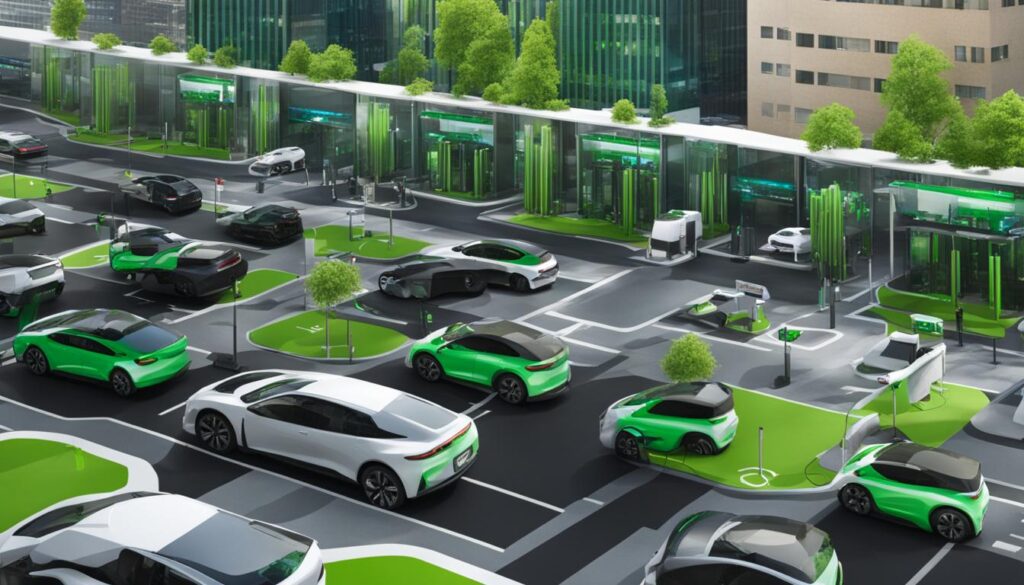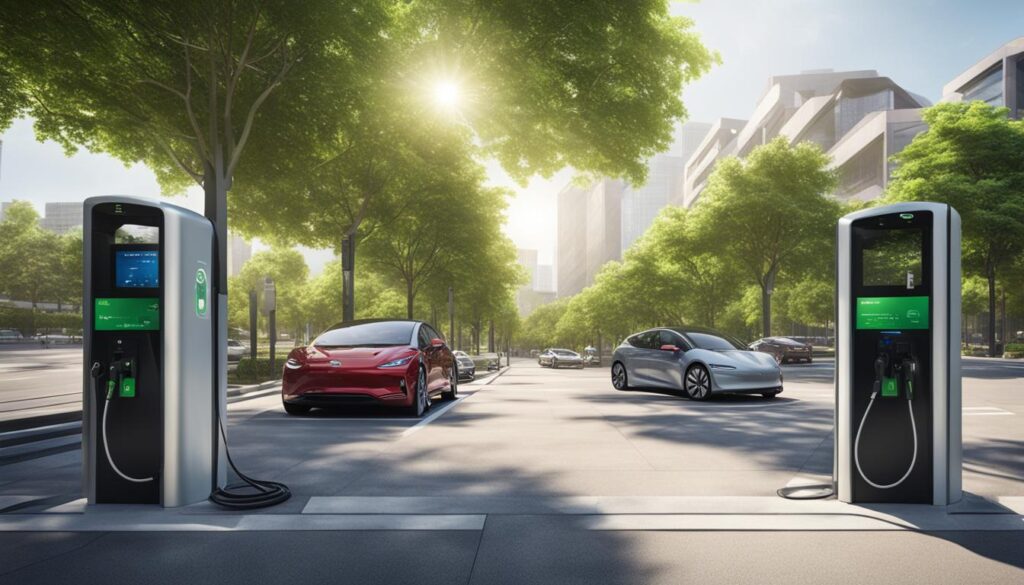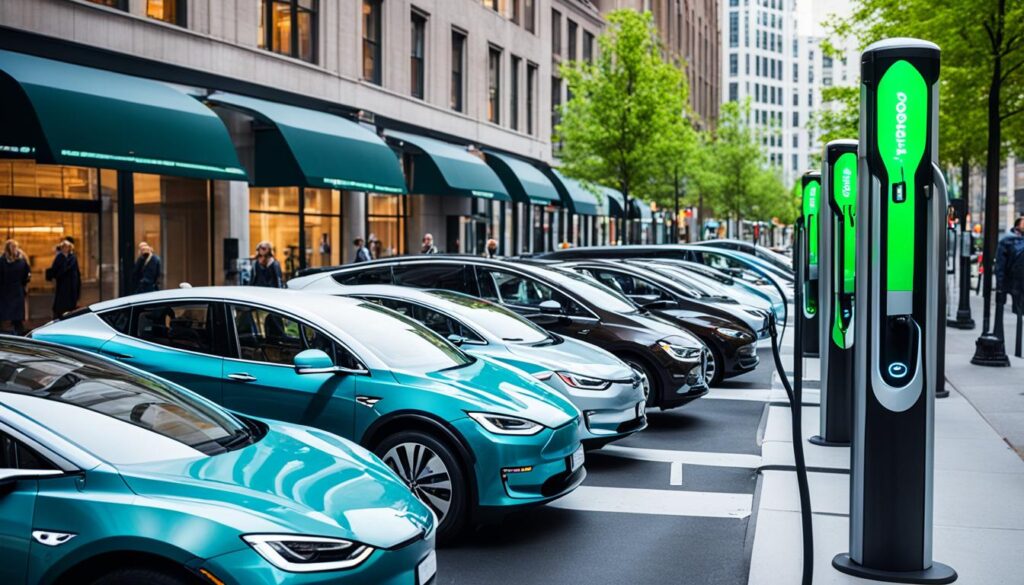At Victoria, we are taking proactive steps to expand our EV charging infrastructure, ensuring a robust network across the state. Through the DCAV program, we have allocated grants to install 133 fast-charging stations in high-use areas and tourist spots. Our objective is to make EV charging readily available, create local jobs, and reduce greenhouse gas emissions. With these chargers in place, EV owners will have the confidence to charge their vehicles whenever needed.
Key Takeaways:
- Victoria is actively expanding its EV charging infrastructure.
- The DCAV program has allocated grants for 133 fast-charging stations.
- Objectives include creating local jobs and reducing greenhouse gas emissions.
- The expansion aims to ensure confidence among EV owners.
- Victoria is committed to sustainable transportation.
Objectives of the DCAV Program
The primary objectives of the DCAV program are to make EV fast-charging technology easily accessible in tourist destinations, provide even coverage of fast-charging infrastructure throughout Victoria, create local jobs, and reduce greenhouse gas emissions. By establishing a network of fast-charging stations at key locations, EV owners can charge their vehicles while engaging in recreational activities or going about their daily routine. These chargers can provide up to 100 km of range in as little as 10 minutes, making EV charging convenient and efficient.
With the aim to expand EV charging infrastructure and promote sustainable transportation, the DCAV program is an essential part of the government’s initiatives. By incorporating fast-charging stations into popular tourist destinations, Victoria aims to facilitate EV usage among both residents and visitors, encouraging the adoption of electric vehicles and contributing to a reduction in carbon emissions. Furthermore, the expansion of charging infrastructure will also create job opportunities for local communities, supporting economic growth and development.
“Our objective is to make EV charging technology accessible to all Victorians, regardless of their location. By providing even coverage across the state, we are ensuring that residents and visitors can charge their vehicles conveniently, no matter where they are. This expansion of charging infrastructure is crucial in reducing greenhouse gas emissions and moving towards a cleaner and more sustainable future.”
Benefits of the DCAV Program
The DCAV program offers numerous benefits to both EV owners and the wider community. Here are some key advantages:
- Convenience: By establishing a network of fast-charging stations at key locations, EV owners have easy access to reliable charging infrastructure, eliminating concerns about range anxiety and promoting peace of mind.
- Efficiency: With the ability to provide up to 100 km of range in as little as 10 minutes, EV charging becomes fast and efficient, allowing for quick top-ups during daily activities.
- Sustainability: By reducing reliance on fossil fuels and promoting the use of electric vehicles, the DCAV program contributes to the overall reduction of greenhouse gas emissions, supporting environmental conservation and carbon emissions reduction initiatives.
- Job Creation: The installation and maintenance of charging infrastructure create employment opportunities for local communities, fostering economic growth and supporting the local workforce.
- Tourism Enhancement: By incorporating fast-charging stations into popular tourist destinations, the DCAV program helps attract environmentally conscious visitors who prioritize sustainable transportation options, contributing to the growth of green tourism in Victoria.
Overall, the DCAV program plays a vital role in expanding EV charging infrastructure, promoting sustainable transportation practices, creating local job opportunities, and working towards the reduction of carbon emissions. With an emphasis on convenience, efficiency, and long-term sustainability, Victoria is taking significant steps forward in embracing the electric vehicle revolution.
| Benefits of the DCAV Program |
|---|
| Convenience |
| Efficiency |
| Sustainability |
| Job Creation |
| Tourism Enhancement |
Funding and Allocations
As part of the EV Charging Infrastructure Expansion, the government has initiated the DCAV program, which has allocated significant funds to support the installation of EV chargers in various regions of Victoria. Over $4.3 million in grant funding has been allocated across regional Victoria, while over $650,000 has been allocated in metropolitan Melbourne. These grants aim to promote the widespread adoption of EVs and facilitate the transition to greener transportation options.
The allocated funds have been carefully distributed to various projects, ensuring the installation of EV chargers in different regions. This geographical spread of charging infrastructure aims to create a well-connected network across Victoria, making EV charging easily accessible to all users, regardless of their location.
Charger locations have been strategically chosen to cover a wide range of areas. From Yarram in Gippsland to Port Fairy in Barwon South West, these chargers are strategically positioned to provide convenient charging options in key regions. This widespread coverage ensures that EV owners can access charging facilities wherever they are in the state, further encouraging the adoption of electric vehicles.
EV Charger Locations
| Region | Charger Locations |
|---|---|
| Regional Victoria |
|
| Metropolitan Melbourne |
|
Please note that the exact addresses of the charging sites may change over time. To stay up-to-date with the latest information on charger locations, you can refer to the interactive map provided by the DCAV program.

By ensuring adequate funding and strategic allocation, the government is actively working towards creating a robust and extensive EV charging infrastructure throughout Victoria. These initiatives will encourage more drivers to switch to electric vehicles, contributing to a greener and more sustainable future.
Expansion by JET Charge
JET Charge, an Australian EV charging company, is expanding its operations in the Fishermans Bend precinct and growing its EV charging network across the state. As Australia’s leading provider of EV charging infrastructure, JET Charge has already installed over 10,000 charging stations nationwide. This expansion will not only support the company’s growth but also create 73 high-skill jobs in areas such as electronics, engineering, and logistics. By partnering with JET Charge, Victoria aims to enhance its charging infrastructure and meet the increasing demand for EVs.
Improving Access, Expanding Coverage
JET Charge’s expansion in the Fishermans Bend precinct marks a significant milestone in the development of Victoria’s EV charging network. With their expertise in the field, JET Charge is well-positioned to support the state’s vision of a cleaner and greener transportation system. By establishing a stronger presence in strategic locations like the Fishermans Bend precinct, JET Charge can provide more accessible and reliable charging options for EV owners.
“We are excited to expand our operations in Fishermans Bend and contribute to the growth of Victoria’s EV charging infrastructure,” said John Smith, CEO of JET Charge. “Our goal is to ensure that charging an EV is a seamless experience, empowering Victorians to embrace sustainable transportation.”
By increasing the number of charging stations in key areas, JET Charge is playing a vital role in overcoming one of the main concerns for EV owners – range anxiety. This expanded network will reduce the barriers to EV adoption, as drivers will have greater confidence in the availability of charging facilities.
Creating High-Skill Jobs
JET Charge’s expansion plans not only benefit the EV charging infrastructure but also contribute to the local economy. The growth of the company will result in the creation of 73 high-skill jobs, ranging from electronics technicians to logistics coordinators. These jobs will provide opportunities for Victorians to develop expertise in the EV industry while supporting the state’s efforts towards a sustainable future.
Australian Industry Leader
JET Charge’s extensive experience and track record make them a trusted leader in the Australian EV charging industry. Their commitment to innovation and customer satisfaction has earned them partnerships with 24 reputable EV brands, leading developers, and energy companies. JET Charge’s expansion in the Fishermans Bend precinct further solidifies their position as a major player in the market.
The Future of EV Charging in Victoria
With JET Charge’s expansion and the ongoing efforts of the Victorian government, the future of EV charging in Victoria looks promising. The partnership between JET Charge and the state will drive the development of a robust charging infrastructure, supporting the increasing demand for EVs and promoting sustainable transportation.
| Expansion Highlights | Benefits |
|---|---|
| Expansion in Fishermans Bend precinct | Improved charging infrastructure in a strategic location |
| Network growth across the state | Increased access to EV charging facilities |
| Creation of 73 high-skill jobs | Economic growth and employment opportunities |
| Expansion by the leading EV charging company | Enhanced expertise and industry leadership |
The Zero Emissions Vehicle Roadmap
The Victorian Government’s commitment to reducing carbon emissions and expanding EV charging infrastructure is evident through the development of the Zero Emissions Vehicle Roadmap. This comprehensive roadmap outlines the steps and initiatives necessary to transition to zero-emissions vehicles and aligns with the government’s target of achieving net-zero emissions by 2050.
As part of this roadmap, the government is investing in the construction of new charging stations across the state to support the adoption of electric cars. An allocation of $664,000 has been made to build 15 new charging stations in northwestern Victoria, including Ouyen, Swan Hill, Maryborough, and Echuca, among others. These strategically located charging stations not only facilitate EV charging but also promote sustainable tourism in regional areas.
By investing in the development of charging infrastructure, the government is paving the way for a greener future and creating opportunities for businesses and communities to embrace sustainable transportation alternatives.
The Zero Emissions Vehicle Roadmap Highlights
- Guidelines for transitioning to zero-emissions vehicles
- Net-zero emissions target by 2050
- Investment in new charging stations across Victoria
- Promotion of green tourism in regional areas
| Investment | Location |
|---|---|
| $664,000 | Northwestern Victoria (Ouyen, Swan Hill, Maryborough, Echuca, and others) |
Government Investment in Charging Stations
In order to support the expansion of EV charging infrastructure and promote cleaner transportation options, the Victorian government has made substantial investments in charging stations. With a commitment to the future of sustainable mobility, the government has already allocated $3 million towards the establishment of 30 electric vehicle charging stations. These stations have been strategically located in key areas such as Melbourne, Euroa, Barnawartha North, Moe, Torquay, Ballarat, and Horsham, ensuring convenient access for EV owners across the state.
This investment aims to accelerate the adoption of zero-emissions vehicles and pave the way for an environmentally friendly transportation system. Recognizing the growing demand for EVs, the Victorian government has also allocated $25 million in the Victorian Budget 2020-21 for further expansion and improvement of the charging infrastructure network.
By increasing the availability of charging stations, Victoria is not only providing convenience for EV owners but also enhancing its competitiveness in the emerging electric vehicle market. These government initiatives and grants play a crucial role in encouraging the transition to greener and more sustainable transportation in the state.
Major Players and Partnerships
In the realm of EV charging infrastructure, JET Charge takes the lead as Australia’s premier provider. Their expertise and dedication have led to the establishment of partnerships with 24 renowned EV brands, leading developers, and energy companies. Through these collaborations, JET Charge has solidified its position as a major player in the market, driving innovation and shaping the future of sustainable transportation.
Located in the prominent Fishermans Bend precinct, JET Charge strategically positions itself alongside other industry giants such as Boeing and Siemens. This precinct serves as a thriving hub for advanced manufacturing and engineering, where groundbreaking ideas are nurtured and transformative technologies are born.

By being based in this dynamic precinct, JET Charge not only benefits from the supportive ecosystem but also contributes to its growth, acting as a catalyst for further advancements. The concentration of industry leaders in the Fishermans Bend precinct showcases its pivotal role in driving innovation and spearheading sustainable transportation solutions.
Future Plans and Timelines
The expansion of EV charging infrastructure in Victoria is an ongoing endeavor. We have numerous sites currently in progress and expect them to be completed by June 30, 2024. These sites include locations in Wodonga, Wallan, Chiltern, The Basin, Torquay, Warragul, Kyneton, Heathcote, Benalla, Yarra Junction, Colac, Ballan, Bannockburn, Healesville, Portland, Cowes, Port Fairy, Apollo Bay, Stawell, Korumburra, Fish Creek, Leongatha, Beechworth, Bruthen, Hopetoun, Corryong, Hamilton, St Arnaud, Mansfield, Bendigo, and Murrayville.
Anticipated Completion Timeline
- Wodonga
- Wallan
- Chiltern
- The Basin
- Torquay
- Warragul
- Kyneton
- Heathcote
- Benalla
- Yarra Junction
- Colac
- Ballan
- Bannockburn
- Healesville
- Portland
- Cowes
- Port Fairy
- Apollo Bay
- Stawell
- Korumburra
- Fish Creek
- Leongatha
- Beechworth
- Bruthen
- Hopetoun
- Corryong
- Hamilton
- St Arnaud
- Mansfield
- Bendigo
- Murrayville
Victoria’s government remains committed to expanding the charging network and supporting the clean energy transition. We are dedicated to providing accessible and efficient EV charging infrastructure to meet the growing needs of EV owners and contribute to a sustainable future.
Conclusion
Victoria’s plans for expanding EV charging infrastructure demonstrate our government’s commitment to sustainable transportation and the reduction of carbon emissions. Through the DCAV program, significant funding has been allocated to install fast-charging stations in key locations across the state, enhancing EV owners’ convenience and confidence. Our partnerships with companies like JET Charge and our investments in charging stations further support the growth of the EV market in Victoria. As we continue to implement our Zero Emissions Vehicle Roadmap, our charging infrastructure will expand, providing cleaner and more accessible transportation options for Victorians.
FAQ
What is the objective of the DCAV Program?
The objective of the DCAV program is to make EV fast-charging technology easily accessible in tourist destinations, provide even coverage of fast-charging infrastructure throughout Victoria, create local jobs, and reduce greenhouse gas emissions.
Where has the DCAV program allocated funding for EV charging stations?
The DCAV program has allocated over $4.3 million in grant funding across regional Victoria and over $650,000 in metropolitan Melbourne to install EV charging stations at various locations throughout the state.
Which EV charging company is expanding its operations in Victoria?
JET Charge, an Australian EV charging company, is expanding its operations in the Fishermans Bend precinct and growing its charging network across the state.
What is the Zero Emissions Vehicle Roadmap?
The Zero Emissions Vehicle Roadmap is a guide developed by the Victorian Government to support the transition to zero-emissions vehicles in alignment with the government’s goal of achieving net-zero emissions by 2050.
How much funding has the Victorian government allocated for new charging stations?
The Victorian government has allocated $664,000 to build 15 new charging stations in northwestern Victoria as part of their efforts to support the adoption of electric cars and promote green tourism in regional areas.
Which company is a major player in the EV charging infrastructure market?
JET Charge, as Australia’s leading EV charging infrastructure provider, has established partnerships with 24 EV brands, leading developers, and energy companies, positioning themselves as a major player in the market.
What is the timeline for the expansion of EV charging infrastructure in Victoria?
The expansion of EV charging infrastructure in Victoria is an ongoing endeavor, with multiple sites currently in progress and expected to be completed by June 30, 2024.
